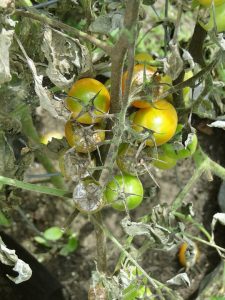Most home gardeners who grow tomatoes have experienced problems with tomato diseases. Tomatoes can suffer a variety of diseases and environmental factors contributing to poor production, foliage damage, or plant death.
Here are a few of them that you might be seeing on your tomato plants this summer with possible solutions to ‘cure’ your plants.
Tomato Fruit Set Failure and Flower Drop: You might notice your plant isn’t setting fruit, or the flowers drop off before fruit sets. High temperatures in the summer or low light intensity are adverse factors that can contribute to this problem. When spring temperatures are low a fruit setting hormone often helps the problem, but will not help in higher summer temperatures. During excessive heat maintaining good leaf cover by using a shade cloth can help. Excess nitrogen can also contribute to blossom drop. Choose a fertilizer specifically for tomato plants.
Wilting, yellowing leaf, branch or plant death: Fusarium wilt and Verticillium wilt are two soil borne pathogens in our area, when present in the soil they can destroy the plants vascular system. Avoid prolonged saturation of the soil and overhead watering, which can cause soil to splash onto leaves, thereby spreading the disease causing pathogens. Remove infected plants and destroy them. Rotate your plants to an uninfected area of your garden next year, and avoid planting in areas which have previously hosted plants from the tomato family like: potatoes, peppers, or eggplant, because they can also be infected with the same wilt diseases. Once present in the soil these pathogens live for years. The very best practice for avoiding Fusarium wilt and Verticillium wilt is to buy disease resistant seeds or plants. Look for the V, F or VF on the description of the tomato variety you are considering.
Sun-scald and Solar Yellowing: These conditions are caused by overexposure to the sun. Sun-scald presents as a light brown, leathery spot on the side of the exposed tomato. Solar yellowing occurs when tomato fruit fails to turn its normal red and usually looks yellow to orange, or red with yellow/orange shoulders. It is caused when the normal red pigment fails to form at temperatures above 86 degrees. Maintaining good plant vigor allows the plant to produce adequate leaf cover, reducing the incidence of these problems.
Blossom End Rot: Fruit develops a brown-black patch on the bottom of the fruit. It can occur in green or mature fruit and certain varieties are more prone to it. The problem occurs when the tomato plant does not get enough calcium from the soil. This might occur because the soil is naturally low in calcium or inconsistent watering prevents the plant from taking up the necessary calcium. Avoid blossom end rot by maintaining even soil moisture. Apply gypsum and water into the soil at planting time. If blossom end rot appears increase the availability of calcium to your plant.
Fruit cracking: Large concentric circles of cracked skin are representative of heavy irrigation or rainfall, particularly after a dry spell. Harvest all mature fruits immediately after a rain in order to avoid these cracks. Large cracks radiating from the stem downward usually are the result of temperatures over 90 degrees, or too much sunlight. Keep soil evenly moist and maintain good leaf cover to reduce the possibility of this problem. Choose plants or seeds that are crack resistant.
For assistance identifying plant diseases and advice on how to best treat them, stop by the UC Master Gardener helpdesk with a sample, or email a photo with an explanation.
Helen Willoughby-Peck is a Mariposa UC Master Gardener
The UC Master Gardener Helpline and Helpdesk are staffed Tuesdays from 9 a.m. – noon, and Thursdays from 2 – 5 p.m. Please contact the helpline by phone at: (209) 966-7078 or via email (send photos and questions for researched answers) to: mgmariposa@ucdavis.edu.
Visit our UCMG website : http://cemariposa.ucanr.edu/Master_Gardener
Follow us on Facebook at: https://www.facebook.com/mariposamastergardeners
Listen to local interviews : KRYZ, 98.5 FM at, http://www.kryzradio.org
Master Gardener Office Location:
UC Cooperative Extension Office,
5009 Fairgrounds Road
Mariposa, CA 95338
Phone: (209) 966-2417
Email: mgmariposa@ucdavis.edu




